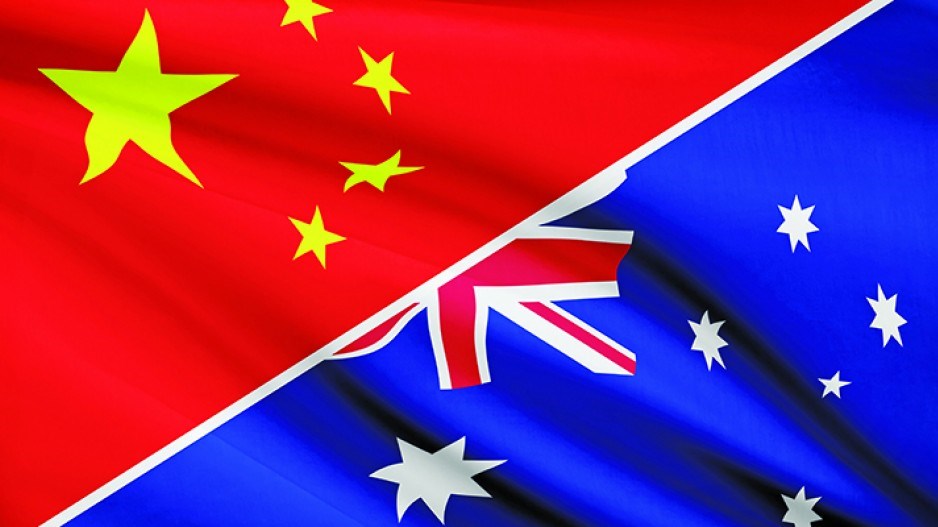After a decade of haggling, China has concluded its first comprehensive free trade agreement with a major western economy, Australia, with ratification scheduled for next year.
The declaration of intent, signed while Chinese President Xi Jinping was in Brisbane for the G20 summit late last month, is being interpreted as a signal from Beijing that it is ready to do business with developed economies on an equal basis. Australian resources industries already count China as their main market, and the new agreement is seen as opening enormous opportunities for Australia’s services industries.
Banks, legal partnerships, financial advisers and insurance companies are licking their lips. Several classes of Australian professionals, such as urban planners and architects, will have their qualifications recognized in China. There will be progressive elimination of tariffs on Australian agricultural products, such as beef, wine and dairy produce, including infant formula, entering the Chinese market.
However, there is already a substantial backlash from Australia’s trade unions and the public at large over what are seen as excessively liberal rules allowing Chinese labour to enter the country and concerns that Beijing is a regional security threat. Indeed, although President Xi characterized the agreement as cementing a “comprehensive strategic partnership” between China and Australia, Prime Minister Tony Abbott is making it clear he does not entirely trust Beijing, and that the agreement does not erode Canberra’s strong support for the United-States-led security alliance in Asia. For example, while the agreement exempts all private Chinese companies investing AU$1 billion ($970 million) or less in Australia from Foreign Investment Review Board scrutiny, all Chinese state-owned investors will continue to be subject to approval, however small the investment.
Abbott’s conservative Liberal Party-led government is backing a parliamentary inquiry into the draft agreement in order to try to build public consensus behind the deal. This may lead to demands for dropping or renegotiating some aspects of the agreement, but there is no expectation at the moment that the major thrusts of the deal will be derailed in this process.
Despite the Abbott government’s reservations about the motives of Chinese state-owned companies, especially their lust for control of innovative technologies, Beijing is well pleased with the agreement.
Tariffs on 95% of all Chinese imports into Australia, such as clothes, footwear, cars and household appliances, will be phased out over four years. The agreement gives China new opportunities for overseas investment, particularly in Australia’s energy, resources and agribusiness companies. This needs to be seen in context. Chinese investors are working from a small base in Australia. Investment from Australia’s other major trading partners – the U.S., Japan and the United Kingdom – has been 10 times that from China since 2008, the first year Chinese investment became significant. Australia can also be expected to supply China with specialized services that are comparable with those offered by U.S. companies, but which have the attraction for Beijing of not being American.
The aspects of the agreement dealing with the movement of labour are precedent-setting for China in its relationship with a developed western economy. Australia’s agreement to accept 5,000 Chinese a year on “working holidays” is headline-grabbing, but not revolutionary. More exceptional is the agreement to allow companies to bring in their own executives and skilled labour in support of their investment projects, especially infrastructure projects. So far, it is these provisions in the agreement that are exciting most concern in Australia. Predictably, trade unions are arguing this will allow Chinese companies to bring in their own workforces and avoid hiring Australians. But one mining association is even saying these provisions threaten the future of their own skilled labour. •
Japan’s Abe seeks new mandate from voters Japanese voters are being asked to give their verdict on Prime Minister Shinzo Abe’s economic policies in a snap election to be held in two weeks, and the chances are they will give it a thumbs-up for lack of any other reasonable option. Campaigning was set to begin December 2 for the election, in which Abe says he needs a renewed popular mandate for “grave” economic decisions after the economy fell back into recession last month. Abe’s Liberal Democratic Party has an overwhelming majority in the Japanese parliament after a convincing win in elections two years ago, so many regard the prime minister’s demand for a new mandate as unconvincing. The truth seems to be that Abe has a better chance of winning another majority now than in two years’ time, when the next election should be held. With doubts mounting about the effectiveness of his three-string “Abenomics” program for the revival of Japan’s stagnant economy, his own popularity strong but beginning to falter and the opposition parties still suffering from their last drubbing, his prospects are unlikely to get better. What tipped the Japanese economy back into recession was the unexpected negative impact of the first of a planned two-part rise in the sales tax in April. This raised the tax from 5% to 8%, and should have been followed by a further rise to 10% in October next year. Abe has decided to postpone that rise for 18 months, which has already won him much public support and even the approval of the parliamentary opposition. Abe may well be calculating that a renewed mandate for Abenomics will strengthen his hand in dealing with Japan’s politically powerful special interests, such as the farm lobby, which have blocked his moves to force reform and thus undermined the entire program. |
Jonathan Manthorpe ([email protected]) has been an international affairs columnist for nearly 40 years.




